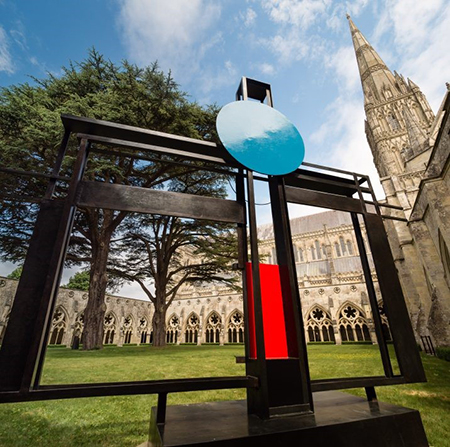The Crucifixion
Continuing our online tour of the Cathedral's 800th anniversary exhibition, this week we are looking at different representations of the Crucifixion in the cathedral exhibition.
In 'Crucifixion 8', Craigie Aitchison presents a cross in isolation from the human world but rooted in the natural world, suggestive of the silhouette of the Holy Isle just off the Isle of Arran.
The deep blue of the sky fades into pink on the horizon which gives way to a green hill while the cross is rooted in the brown earth while rising through the other 3 colours. Birds are perched on the cross beam and though the traditional halo is clear, the pale, almost featureless body seems to blend in with the cross as though becoming one with it.
It is as though the human person has become absorbed into the act. The crucifixion itself has become one with nature, as though the sacrifice is made for all living things and not just for us.
Barbara Hepworth, by contrast, presents an almost abstract version of crucifixion implied by the full title Construction (Crucifixion) as though the shape and colour of what has been constructed in the cloister should first claim our attention turning us away from preconceived ideas about the cross.
'Construction (Crucifixion)' photo by Ash Mills
(Such pre-conceived ideas led to the vandalisation of this piece when it was first installed in 1969, when it was daubed with paint, and a bomb - which did not go off - was lodged under its base.)
What we see are 3 verticals linked by a single horizontal bar, and by 2 other horizontals at different heights.
A large circle, attached to the intersection of the horizontal and vertical lines, is painted citrus yellow on one side and blue on the other. At the bottom of the central vertical, we see red on its own beneath the blue side of the circle, and red and white beneath the yellow. On the yellow side, a metal hoop encircles the point of crossing.
Hepworth wrote that she found it ‘very serene and quiet’, but that doesn’t have to guide what we make of this piece. We could see the yellow circle as the sun, the blue circle as the moon, the red paint as blood, the 2 verticals on either side as the crosses of the 2 men crucified with Jesus.
Or we could contemplate its hardness, weight, size (12ft tall and 2-and-a-half tons) and stark simplicity. We could seek to find meaning here, or we could stand before it and try to imagine the experience of meaningless horror and sheer emptiness which brutality of any kind must impose on those who witness it. For us, it need not seem ‘serene and quiet’ as for Hepworth. On the contrary this cross might confront us with the tragic lack of meaning which has so often afflicted humanity since the cross of Christ was first set up.
Document Actions



